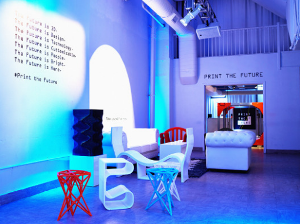Mar 15 2017
Instead of ordering a sofa online, or making the dreaded Saturday trek to overcrowded furniture stores to pick out a table or chair, what if you could pick a piece of furniture, and then watch it get built right in front of your eyes? While 3D printed furniture is certainly not a new concept, custom 3D printed furniture that’s made for customers onsite in a trendy pop-up shop certainly is! We’ve seen 3D printed concrete furniture that’s made right on the spot in front of people, but the furniture 3D printed by Vancouver-based firm Print the Future looks much more comfortable and stylish. Print the Future recently opened a pop-up shop in Manhattan, and if everything goes according to CEO and founder Neil Patel’s plan, the company will be opening shops all over the world.
 Credit: 3D Printing
Credit: 3D Printing
Just looking at this picture of the Manhattan shop gives me good vibes, and I love the wall writing…and that little white table. The shop, which is open until March 31, offers custom, competitively-priced 3D printed furnishings (everything costs $500-$1500), all of which are made from 100% recyclable materials. The vision here is sustainability: 3D printed furniture uses exactly the amount of material necessary, without wasting any. Patel thinks that the concept of customers watching their furniture being created right in front of them of them, and then picking the completed piece up later at a local store, could completely disrupt the existing furniture market, as shipping could potentially be eliminated from the equation. The goal is to sell affordable designer furniture that can “go from idea to 3D reality in just 24 hours.”
Print the Future aims to empower a community of designers, so they can turn their design ideas into beautiful, usable 3D objects and sell right to consumers – no fuss, no muss. In turn, the Manhattan pop-up shop will open the consumers’ eyes to the fact that 3D printing technology is actually a real, practical manufacturing method for useful products, and not just a gimmicky way of making your own Yoda figurine.
The company has already set up large-scale printing operations with partners in Germany and Sweden, but the overall plan is roll out the pop-up shop model and open more shops in cities around the world. That way, customers can walk in the door of the closest shop, talk with designers about their 3D printed furniture ideas, and watch their tables, couches, and chairs come to life in front of them. As they likely won’t be able to stick around and watch the entire printing process, customers can return when the furniture is finished to pick it up, cutting out shipping and delivery fees entirely.
Delivery technology has been on the brain a lot in recent years; we’ve seen it come to life with delivery drones like the Flirtey, though I don’t think one of those drones could deliver a couch.
Patel said, “I grew up watching Doctor Who, and what we’re talking about is that science fiction concept of zapping ideas across space. The idea that you can upload a design and have it materialize as a complete product halfway across the world, is incredibly powerful.”
Fast Company writer Alice Bonasio had a chance to watch the company’s BigRep 3D printer in action (BigRep is currently displaying its massive and not-so-massive 3D printers at South by Southwest this week). She agreed with Patel’s thought that having a physical shop, where customers can watch the furniture being built and touch the products themselves, is a “game changer.”
“When I visited the pop-up shop for the first time, they set the printer to make an intricate blue stool, and what started out as a flat disc of plastic gradually starting taking form as we talked and the layers built up,” said Bonasio. “By the time I came back the next day, it had been completely finished, and I sat on that stool as we finished our interview. Seeing something born in front of your eyes like builds an emotional attachment to that object, and logic dictates that’s a good thing for the seller, since it makes you more likely to buy it.”
Print the Future has a fairly aggressive plan: to capture at least 5-10% of the 3D printing market. Kabuni, Patel’s previous company, is a marketplace for interior designers to connect with customers, and Print the Future will use that community as a jumping-off point. Print the Future board member and award-winning designer Lori Dennis, whose signature line of 3D printed furniture will be available at the pop-up shop, says that as time goes on, designers will be able to really use their creativity in terms of 3D printing materials, and that “we’ve only just started scratching the surface as far as exploring the design possibilities enabled by the medium.”
Dennis explained, “It’s probably safe to say that the majority of our early adopters will be millennials who value customization and speed.”
While many may not look at 3D printing as a speedy means of manufacturing, Dennis explained that she wanted a customized tray to show her audience when she was speaking at a conference in L.A., and called on Print the Future COO Raj Bharti. She sent Bharti her design, and in less than 20 hours, the custom tray had been 3D printed and sent to her.
But again, if the planned pop-up shops do well, shipping could well be eliminated, as customers can just go to the nearest location to pick up their furniture. Patel’s larger vision isn’t just to make pretty 3D printed furniture, but to build up a sustainable 3D printing ecosystem that saves billions of dollars in shipping costs, reducing the overall carbon footprint and developing a decentralized, consumer-focused economy.